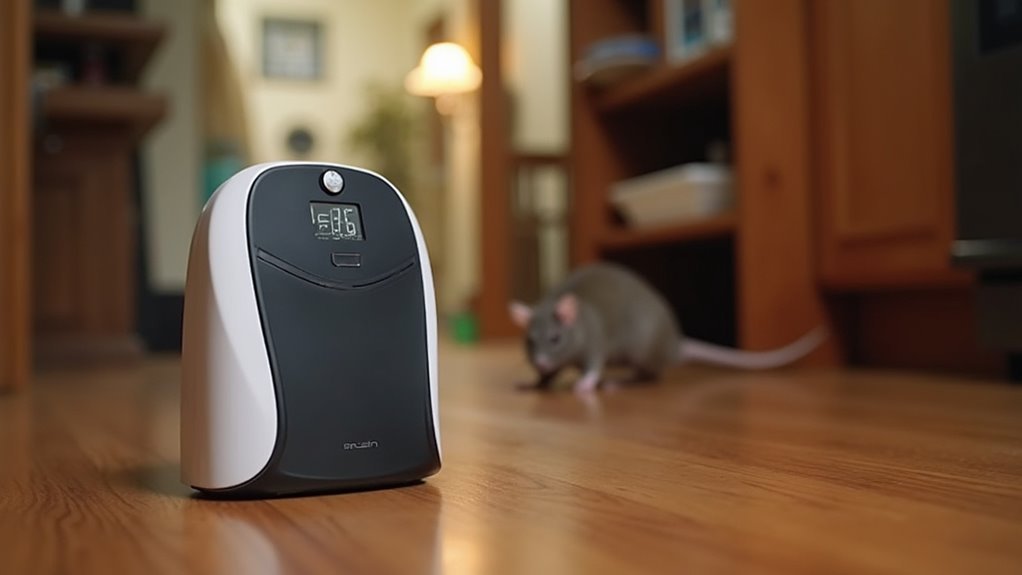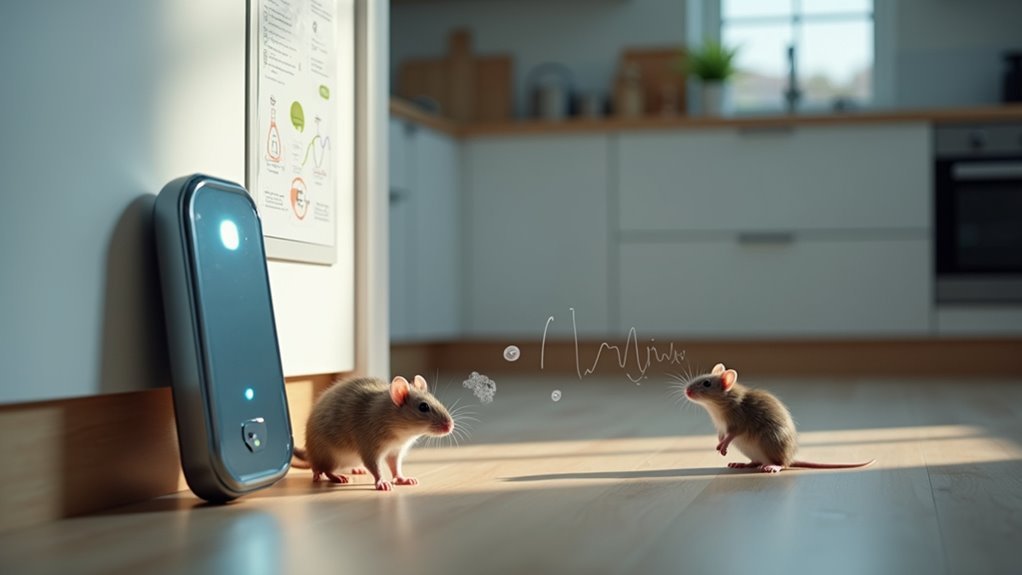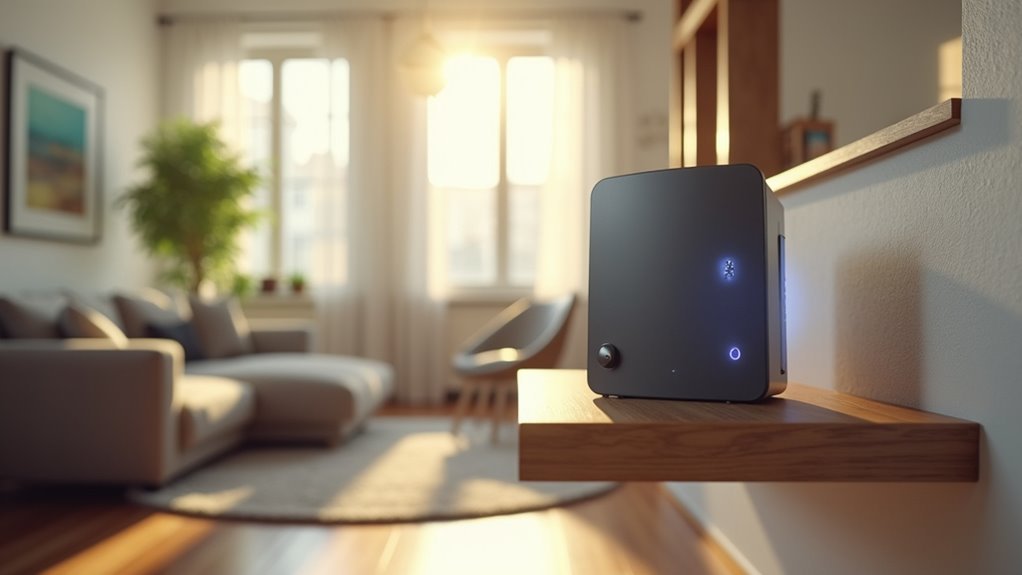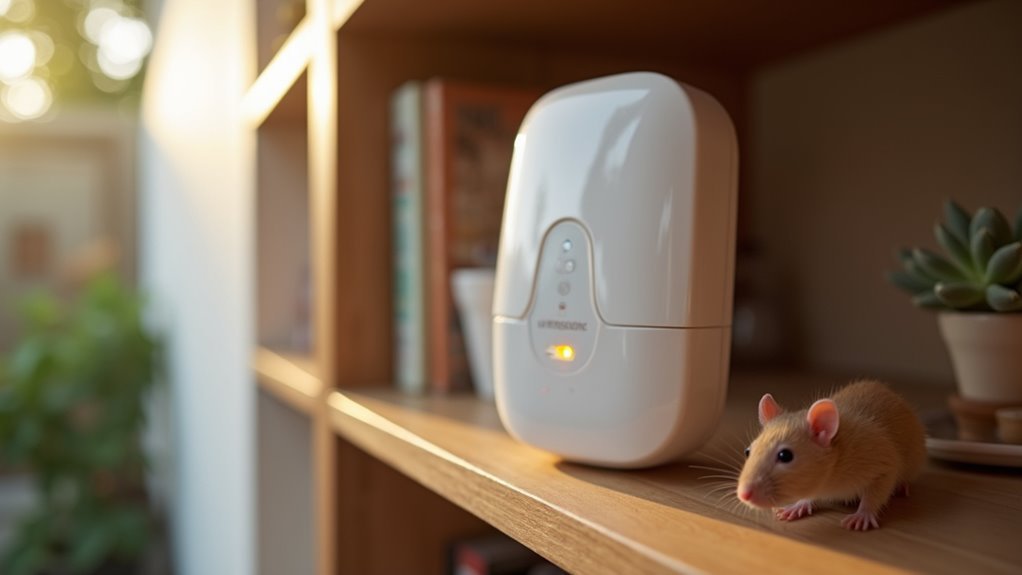You’ll find that most ultrasonic rat repellers show mixed effectiveness, but the LONAOO Ultrasonic Mouse Repellent stands out with its three operational modes and 80-120 square meter coverage. The Morneve Ultrasonic Plug-In 4-pack offers budget-friendly protection at $35.99, while generic brands provide 50-100 square meter coverage for $20-50. These devices work best when you combine variable frequencies with proper placement 12 inches above floor level. Understanding ideal positioning and frequency patterns can dramatically improve your results.
How Ultrasonic Rat Repellers Work

While you can’t hear the high-frequency sounds they produce, ultrasonic rat repellers emit sound waves between 20 kHz and 65 kHz that create an uncomfortable acoustic environment for rodents.
These devices plug into electrical outlets and operate continuously to disrupt rats’ essential behaviors. The ultrasonic pest repellers emit frequencies that interfere with rats’ communication, navigation, and food-locating abilities, causing distress and disorientation that theoretically drives them away.
However, effectiveness varies considerably based on rat species and environmental factors.
You’ll find that rats may gradually habituate to these sounds over time, reducing their impact.
That’s why you shouldn’t rely solely on ultrasonic devices for serious rodent infestations. Instead, combine them with other proven pest control methods for ideal results and long-term effectiveness.
Top-Rated Ultrasonic Rat Repeller Models
Based on customer reviews and testing data, several ultrasonic rat repellers stand out for their performance and reliability. When you’re dealing with a rodent infestation, these top-rated models can help address your pest problems effectively.
| Model | Coverage Area | Price (CAD) |
|---|---|---|
| LONAOO Ultrasonic Mouse Repellent | 80-120 sq meters | Not specified |
| Morneve Ultrasonic Plug-In (4-pack) | Varies by model | $35.99 |
| Generic Brand Options | 50-100 sq meters | $20-50 |
The LONAOO model excels with three operational modes and impressive coverage. You’ll appreciate the Morneve 4-pack’s budget-friendly pricing while maintaining effectiveness. Remember that ultrasonic devices work best in open spaces since furniture can block sound waves, potentially reducing their impact on your pest problems.
Scientific Evidence Behind Ultrasonic Pest Control

You’ll find that scientific research on ultrasonic pest control presents mixed and often contradictory results.
Studies show these devices affect different pests in varying ways – they might repel crickets but prove ineffective against cockroaches and ants.
What works in controlled laboratory settings doesn’t always translate to real-world effectiveness in your home environment.
Research Study Results
Scientific studies reveal mixed results when it comes to ultrasonic pest control effectiveness. While pest control experts continue analyzing these devices, the scientific evidence shows considerable variations in performance across different species.
Kansas State University’s research demonstrated that ultrasonic repellents successfully deterred crickets but failed against cockroaches. Meanwhile, ants and spiders remained completely unaffected by these devices.
You’ll find that environmental obstacles like walls and furniture can block ultrasonic signals, reducing their real-world effectiveness.
Key limitations you should consider include:
- Species-specific results – effectiveness varies dramatically between pest types
- Habituation over time – pests adapt to continuous ultrasonic noise, reducing long-term impact
- Environmental interference – physical barriers considerably limit signal transmission
Currently, there’s no solid scientific consensus supporting consistent effectiveness across all pest species.
Pest Response Variability
While researchers continue studying ultrasonic technology, pest response patterns reveal significant inconsistencies that you can’t ignore when choosing these devices. Pest response variability shows that rodents and other pests react differently to ultrasonic frequencies, making universal effectiveness nearly impossible.
| Pest Type | Response to Ultrasonic Repellers |
|---|---|
| Crickets | Show measurable responsiveness |
| Cockroaches | Remain largely unaffected |
| Ants | Display minimal to no reaction |
| Rats/Mice | Mixed results depending on frequency |
You’ll find that different pests require specific frequency ranges, so single-device solutions often fail. Environmental factors like walls and furniture further complicate effectiveness by blocking sound waves. Additionally, pests can habituate to consistent ultrasonic sounds over time, reducing long-term performance of these devices.
Laboratory Versus Reality
Laboratory testing reveals promising results for ultrasonic pest repellers, but real-world performance tells a different story. While controlled studies show that sound waves can disrupt specific rodents like crickets, the efficacy drastically diminishes when these devices enter your home environment.
Three critical factors explain this laboratory-versus-reality gap:
- Environmental barriers – Furniture, walls, and room layout block ultrasonic transmission
- Pest adaptation – Rodents quickly habituate to repetitive sound frequencies over time
- Species variation – What works on one pest may fail completely against others
Kansas State University research confirms this inconsistency across different species. Your real living space presents obstacles that sterile lab conditions don’t account for.
Experts recommend treating ultrasonic repellers as supplementary tools rather than primary pest control solutions.
Coverage Area and Room Size Considerations

You’ll need to take into account your room’s size when selecting an ultrasonic rat repeller, as most devices effectively cover 800 to 1,200 square feet.
Your device’s performance drops considerably in larger spaces where sound waves can’t reach every corner.
You’ll face additional limitations when walls, furniture, and other obstacles block the ultrasonic frequencies from reaching their intended targets.
Optimal Coverage Range
Most ultrasonic rat repellers effectively cover between 800 to 1,200 square feet, though this range varies greatly based on your room’s layout and obstacles.
You’ll need to take into account how walls, furniture, and other obstructions can considerably reduce the effective range of these devices.
To maximize your ultrasonic repellers’ ideal coverage range, follow these placement strategies:
- Position devices elevated – Mount units 3-4 feet high to avoid furniture blocking sound waves
- Target high-activity areas – Place repellers where you’ve observed rat droppings or gnaw marks
- Use multiple units for large spaces – Install additional devices in rooms exceeding 1,000 square feet
Remember that ultrasonic repellers work best when combined with traditional pest control methods, especially in complex room layouts where sound waves can’t penetrate effectively.
Room Size Limitations
Room size presents the most critical limitation for ultrasonic rat repellers, as these devices lose effectiveness dramatically in spaces exceeding their designed coverage area.
Most units cover 80-120 square meters, so you’ll need to match your device’s specifications to your room’s dimensions for ideal results.
Furniture blocks ultrasonic waves, creating dead zones where rats can hide undetected. You’ll want to position devices strategically near known rodent activity areas, ensuring clear pathways for sound transmission.
Environmental factors like humidity and dust absorb sound waves, reducing effective coverage in larger spaces.
For rooms exceeding your device’s range, you’ll need multiple units to maintain extensive protection. This prevents rats from adapting to sound patterns while ensuring consistent ultrasonic wave distribution throughout your space.
Frequency Range and Sound Pattern Features
When selecting an ultrasonic rat repeller, you’ll want to focus on devices that emit frequencies between 20 kHz and 65 kHz, as this range effectively targets rodents while remaining inaudible to human ears.
The frequency range and sound patterns greatly impact effectiveness, so choose wisely.
The right frequency range and sound patterns make the difference between effective rodent deterrence and wasted investment.
Look for these key features in quality ultrasonic devices:
- Variable frequency settings – Multiple frequencies prevent rats from becoming habituated to constant tones
- Pulsing sound patterns – Intermittent emissions create ongoing distress and confusion in rodents
- Electromagnetic wave combination – Dual-technology approach enhances pest deterrence across various species
The intensity and modulation of emitted sounds directly influence rats’ physiological responses, causing discomfort that drives them away.
Sound patterns that constantly change prove most effective, as they prevent adaptation while maintaining the psychological pressure needed for successful rodent control.
Safety for Pets and Children
Although ultrasonic rat repellers offer an effective pest control solution, you’ll need to evaluate their potential impact on your household’s four-legged family members.
Most dogs and cats aren’t greatly affected by these high-frequency sounds, making ultrasonic pest repellers safe for common household pets. However, smaller animals like rabbits, guinea pigs, and certain birds may experience distress from the inaudible frequencies.
When choosing devices, select models designed to minimize interference with other electronic devices in your home.
Studies confirm these repellers pose no harmful effects to humans or pets you’re dealing with when used correctly. You should monitor sensitive animals’ behavior after installation, as some may react negatively.
While marketed as child-safe, always follow manufacturer directions to guarantee peak safety for your entire household.
Installation and Placement Best Practices
You’ll maximize your ultrasonic rat repeller’s effectiveness by positioning it correctly and ensuring clear signal transmission throughout your space.
The device’s placement directly impacts how well ultrasonic waves disperse, so you can’t simply plug it in anywhere and expect results.
Proper installation requires understanding ideal height positioning, avoiding interference from obstacles, and calculating adequate room coverage for your specific area.
Optimal Device Positioning
Three critical factors determine whether your ultrasonic rat repeller will successfully deter rodents: height, location, and coverage area.
Ideal device positioning requires strategic placement where these pests you’re dealing with are most active.
Mount your ultrasonic repellers at least 12 inches above floor level, allowing sound waves to disperse freely without furniture obstruction. Target high-activity zones like entry points, nesting sites, and food storage areas for maximum impact.
Follow these positioning guidelines:
- Avoid corners and behind furniture – solid objects block sound transmission
- Install multiple units in larger spaces for thorough coverage
- Regular maintenance prevents dust buildup that reduces sound emission
Proper placement guarantees your devices reach their full deterrent potential against rodent infestations.
Avoiding Signal Interference
Beyond proper placement, electromagnetic interference can considerably reduce your ultrasonic repeller’s performance. Keep your device away from Wi-Fi routers, microwaves, and other electronic equipment that can disrupt the high-frequency signals.
Since ultrasonic devices emit high-frequency sound waves, any competing frequencies will diminish their effectiveness against rodents and insects. Position repellers at least six feet from televisions, computers, and wireless speakers to prevent signal overlap.
Monitor humidity levels in your home, as excessive moisture absorbs ultrasonic waves and weakens their reach to entry points where pests typically access your property.
Check your device regularly and relocate it if you notice interference patterns. Multiple repellers in adjacent rooms can also create conflicting frequencies, so space them strategically throughout your home for maximum coverage without signal competition.
Room Coverage Requirements
Understanding your room’s dimensions directly impacts how many ultrasonic repellers you’ll need for effective rat control. Most ultrasonic devices cover between 800 to 1,200 square feet, but obstacles and room layout affect actual coverage.
To meet your room coverage requirements effectively, consider these placement strategies:
- Calculate square footage – Measure each room’s length and width to determine if you need multiple units for larger spaces.
- Account for obstructions – Furniture and walls block ultrasonic waves, reducing coverage area considerably.
- Plan for multiple rooms – Each room typically requires its own device since sound waves don’t travel through walls.
You’ll achieve ideal performance by positioning devices with clear sight lines and avoiding placement behind obstacles that interfere with sound distribution throughout your space.
Effectiveness Against Different Rat Species
When evaluating ultrasonic rat repellers, you’ll find that their effectiveness varies considerably between different rat species. Research shows mixed results, with some frequencies proving more effective against specific species while others exhibit resistance or habituation to the sounds.
| Rat Species | Scientific Name | Ultrasonic Response |
|---|---|---|
| Brown Rat | Rattus norvegicus | Moderate effectiveness |
| Black Rat | Rattus rattus | Variable results |
| Roof Rat | Rattus rattus | Limited success |
The way pest repellers make different pests react depends largely on individual species characteristics. Brown rats typically show moderate response to ultrasonic frequencies, while black rats demonstrate more variable reactions. You’ll notice that sound to deter pests works best when targeting specific frequency ranges for particular species, though habituation remains a significant challenge across all rat types.
Combining Ultrasonic Repellers With Other Methods
Three key strategies can greatly boost your ultrasonic repeller’s performance when you integrate them with complementary pest control methods.
Combining ultrasonic repellers with traditional pest control methods creates a more effective defense system against household rodents.
You’ll achieve better results against household pests by creating a thorough defense system rather than relying solely on ultrasonic technology. Since rats can become habituated to ultrasonic sounds over time, rotating between different approaches prevents adaptation and maintains effectiveness.
Enhance your pest control strategy with these proven combinations:
- Traditional traps and chemical pesticides – Address different behavioral aspects while ultrasonic repellers create environmental pressure.
- Natural deterrents like peppermint oil – Target multiple senses simultaneously for increased repelling power.
- Preventive measures – Regular cleaning and sealing entry points reduce infestation likelihood.
Monitor pest activity continuously and adjust your strategy based on observed behavior. This multi-faceted approach maximizes your chances of successfully repelling rats.
Cost Analysis and Long-Term Value
Although ultrasonic rat repellers offer an attractive upfront investment at $30-50 for most models, you’ll need to evaluate their true cost-effectiveness beyond the initial purchase price. Your cost analysis should factor in replacement cycles every 3-6 months and potential supplementary pest control methods.
| Cost Factor | Initial Investment | 3-Year Total |
|---|---|---|
| Device Only | $30-50 | $180-600 |
| With Traps | $50-80 | $300-800 |
| Professional Backup | $150-300 | $600-1,200 |
The long-term value depends heavily on effectiveness in your specific situation. Since ultrasonic repellers show mixed results, you might need additional solutions like traps or professional services. While manufacturers claim 3-5 year lifespans, real-world performance often requires more frequent replacements, potentially diminishing the economic advantage over traditional pest control methods.
Frequently Asked Questions
Do Ultrasonic Rat Repellers Really Work?
You’ll find ultrasonic rat repellers have mixed effectiveness. They might deter some rodents temporarily, but rats often ignore them or become habituated. You shouldn’t rely on them alone for serious infestations.
What Is the Most Effective Rat Repellent?
You’ll find ultrasonic devices like LONAOO most effective, covering 80-120 square meters. However, you shouldn’t rely solely on them—combine with physical barriers and traditional methods for thorough rat control success.
Do Ultrasonic Rodent Repellers Work Consumer Reports?
Consumer Reports shows you’ll get mixed results with ultrasonic rodent repellers. You might see some success, but they’re not consistently effective against rats and mice, so you shouldn’t rely on them alone.
What Is the Best Home Defense for Rats?
You’ll need a multi-layered approach combining ultrasonic repellers with traditional traps and sealing entry points. Store food in airtight containers, clean regularly, and use physical barriers like rodent control fabric for maximum effectiveness.
In Summary
You’ll find ultrasonic rat repellers can be effective tools in your pest control strategy, but they’re not magic solutions. Choose models with multiple frequencies and adequate coverage for your space, place them strategically following manufacturer guidelines, and don’t expect instant results. For best outcomes, you’ll want to combine ultrasonic devices with traditional methods like sealing entry points and removing food sources. With realistic expectations and proper implementation, these devices offer decent long-term value.





Leave a Reply